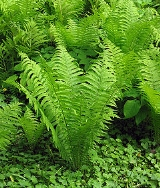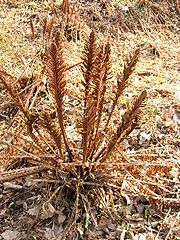
Ostrich fern
Encyclopedia
The ostrich fern or shuttlecock fern (Matteuccia struthiopteris) is a crown-forming, colony-forming fern
, occurring in temperate regions of the Northern Hemisphere
in eastern and northern Europe
, northern Asia
and northern North America
.
 It grows from a completely vertical crown, favoring riverbanks and sandbars, but sends out lateral stolon
It grows from a completely vertical crown, favoring riverbanks and sandbars, but sends out lateral stolon
s to form new crowns. It thus can form dense colonies resistant to destruction by floodwaters.
The frond
s are dimorphic, with the deciduous
green sterile fronds being almost vertical, 100-170 cm tall and 20-35 cm broad, long-tapering to the base but short-tapering to the tip, so that they resemble ostrich
plumes, hence the name. The fertile fronds are shorter, 40-60 cm long, brown when ripe, with highly modified and constricted leaf tissue curled over the sporangia
; they develop in autumn, persist erect over the winter and release the spore
s in early spring.
Matteuccia species are used as food plants by the larva
e of some Lepidoptera
species including Sthenopis auratus
.
in garden
s. While choosing a place of planting it should be taken into account that these ferns are very expansive and its leaves often lose their beauty throughout the summer, especially if not protected from wind and hail. The tightly wound immature fronds, called fiddleheads, are also used as a cooked vegetable
, and are considered a delicacy mainly in rural areas of northeastern North America
. The young shoots can also be eaten raw in salads or as a snack in the field.
The plants are also grown in Japan
, where the sprouts ("kogomi" in Japanese) are a delicacy.
and Onoclea (sensitive fern) than it is to M. orientalis and M. intermedia, and so the latter should be moved to a genus Pentarhizidium
which contains those two species.
Formerly classified as a member of the Dryopteridaceae
, Matteuccia has been reassigned to the new much smaller family Onocleaceae
.
Fern
A fern is any one of a group of about 12,000 species of plants belonging to the botanical group known as Pteridophyta. Unlike mosses, they have xylem and phloem . They have stems, leaves, and roots like other vascular plants...
, occurring in temperate regions of the Northern Hemisphere
Northern Hemisphere
The Northern Hemisphere is the half of a planet that is north of its equator—the word hemisphere literally means “half sphere”. It is also that half of the celestial sphere north of the celestial equator...
in eastern and northern Europe
Europe
Europe is, by convention, one of the world's seven continents. Comprising the westernmost peninsula of Eurasia, Europe is generally 'divided' from Asia to its east by the watershed divides of the Ural and Caucasus Mountains, the Ural River, the Caspian and Black Seas, and the waterways connecting...
, northern Asia
Asia
Asia is the world's largest and most populous continent, located primarily in the eastern and northern hemispheres. It covers 8.7% of the Earth's total surface area and with approximately 3.879 billion people, it hosts 60% of the world's current human population...
and northern North America
North America
North America is a continent wholly within the Northern Hemisphere and almost wholly within the Western Hemisphere. It is also considered a northern subcontinent of the Americas...
.

Stolon
In biology, stolons are horizontal connections between organisms. They may be part of the organism, or of its skeleton; typically, animal stolons are external skeletons.-In botany:...
s to form new crowns. It thus can form dense colonies resistant to destruction by floodwaters.
The frond
Frond
The term frond refers to a large, divided leaf. In both common usage and botanical nomenclature, the leaves of ferns are referred to as fronds and some botanists restrict the term to this group...
s are dimorphic, with the deciduous
Deciduous
Deciduous means "falling off at maturity" or "tending to fall off", and is typically used in reference to trees or shrubs that lose their leaves seasonally, and to the shedding of other plant structures such as petals after flowering or fruit when ripe...
green sterile fronds being almost vertical, 100-170 cm tall and 20-35 cm broad, long-tapering to the base but short-tapering to the tip, so that they resemble ostrich
Ostrich
The Ostrich is one or two species of large flightless birds native to Africa, the only living member of the genus Struthio. Some analyses indicate that the Somali Ostrich may be better considered a full species apart from the Common Ostrich, but most taxonomists consider it to be a...
plumes, hence the name. The fertile fronds are shorter, 40-60 cm long, brown when ripe, with highly modified and constricted leaf tissue curled over the sporangia
Sporangium
A sporangium is an enclosure in which spores are formed. It can be composed of a single cell or can be multicellular. All plants, fungi, and many other lineages form sporangia at some point in their life cycle...
; they develop in autumn, persist erect over the winter and release the spore
Spore
In biology, a spore is a reproductive structure that is adapted for dispersal and surviving for extended periods of time in unfavorable conditions. Spores form part of the life cycles of many bacteria, plants, algae, fungi and some protozoa. According to scientist Dr...
s in early spring.
Matteuccia species are used as food plants by the larva
Larva
A larva is a distinct juvenile form many animals undergo before metamorphosis into adults. Animals with indirect development such as insects, amphibians, or cnidarians typically have a larval phase of their life cycle...
e of some Lepidoptera
Lepidoptera
Lepidoptera is a large order of insects that includes moths and butterflies . It is one of the most widespread and widely recognizable insect orders in the world, encompassing moths and the three superfamilies of butterflies, skipper butterflies, and moth-butterflies...
species including Sthenopis auratus
Sthenopis
Sthenopis is a genus of moths of the family Hepialidae. There are eight described species found in North America and China.-Species:*Sthenopis argenteomaculatus - Canada/United States*Recorded food plants: Alnus, Betula, Salix...
.
Cultivation and uses
The ostrich fern is a popular ornamental plantOrnamental plant
Ornamental plants are plants that are grown for decorative purposes in gardens and landscape design projects, as house plants, for cut flowers and specimen display...
in garden
Garden
A garden is a planned space, usually outdoors, set aside for the display, cultivation, and enjoyment of plants and other forms of nature. The garden can incorporate both natural and man-made materials. The most common form today is known as a residential garden, but the term garden has...
s. While choosing a place of planting it should be taken into account that these ferns are very expansive and its leaves often lose their beauty throughout the summer, especially if not protected from wind and hail. The tightly wound immature fronds, called fiddleheads, are also used as a cooked vegetable
Vegetable
The noun vegetable usually means an edible plant or part of a plant other than a sweet fruit or seed. This typically means the leaf, stem, or root of a plant....
, and are considered a delicacy mainly in rural areas of northeastern North America
Atlantic Northeast
The Atlantic Northeast, or Arcadia, is a region of North America, comprising New Hampshire, Vermont, Maine and the Canadian Maritimes. Definitions of the region vary; it may extend to upstate New York and/or all of Atlantic Canada....
. The young shoots can also be eaten raw in salads or as a snack in the field.
The plants are also grown in Japan
Japan
Japan is an island nation in East Asia. Located in the Pacific Ocean, it lies to the east of the Sea of Japan, China, North Korea, South Korea and Russia, stretching from the Sea of Okhotsk in the north to the East China Sea and Taiwan in the south...
, where the sprouts ("kogomi" in Japanese) are a delicacy.
Classification
Matteuccia struthiopteris is the only species in the genus Matteuccia. Some sources include two Asian species, M. orientalis and M. intermedia, but molecular data shows that M. struthiopteris is more closely related to OnocleopsisOnocleopsis
Onocleopsis is a genus of ferns in the family Onocleaceae containing only one extant species ....
and Onoclea (sensitive fern) than it is to M. orientalis and M. intermedia, and so the latter should be moved to a genus Pentarhizidium
Pentarhizidium
Pentarhizidium is a genus of two Asian fern species. These species have formerly been included in Matteuccia or Onoclea. Recent genetic analysis has determined that these two species form a discrete clade that is basal to the rest of this fern group, and so have been located in their own genus. P...
which contains those two species.
Formerly classified as a member of the Dryopteridaceae
Dryopteridaceae
Dryopteridaceae, is a family of leptosporangiate ferns in the order Polypodiales. They are known colloquially as the wood ferns. They comprise about 1700 species and have a cosmopolitan distribution. They may be terrestrial, epipetric, hemiepiphytic, or epiphytic. Many are cultivated as...
, Matteuccia has been reassigned to the new much smaller family Onocleaceae
Onocleaceae
Onocleaceae is a small family of terrestrial ferns. There are four genera of onocleoids: Matteuccia, Onoclea, Onocleopsis, and Pentarhizidium, consisting of five species largely in north temperate climes....
.
Sources
- Flora of North America: Matteucia struthiopteris
- Germplasm Resources Information Network: Matteuccia struthiopteris
- Hyde, H. A., Wade, A. E., & Harrison, S. G. (1978). Welsh Ferns. National Museum of Wales.

